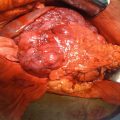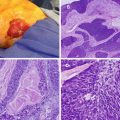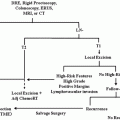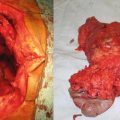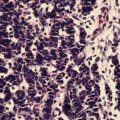Fig. 7.1
Algorithm for management of pregnancy-associated breast cancer (Courtesy of Roger H. Kim, MD, FACS and Quyen D. Chu, MD, MBA, FACS)
Imaging
Mammography is not contraindicated in pregnancy and can still be obtained with proper abdominal shielding for fetal protection. Exposure to the fetus from mammography is estimated at 0.004 Gy, significantly lower than the recommended limit of 0.05 Gy [2, 3, 5]. However, the sensitivity of mammography is decreased in the pregnant breast, to about 70 % [2, 3]. Because of this, ultrasound is generally the first modality utilized for evaluation of a breast mass. If the mass has suspicious features on ultrasound, bilateral mammograms should be obtained.
Biopsy
Biopsy of suspicious lesions should be performed. Fine-needle aspiration (FNA) cytology is more difficult to interpret in pregnancy due to physiologic changes in the breast that mimic atypia [2, 3]. For this reason, the pathologist should be informed of the pregnancy or lactation status of patients who undergo FNA. Core needle biopsy can be obtained safely under local anesthesia during pregnancy. Excisional biopsy may also be performed under local anesthesia for tissue diagnosis.
Surgery
Surgery for breast cancer can be safely performed at any stage of pregnancy. There are multiple reports that demonstrate there is no increase in fetal abnormalities for pregnant patients undergoing general anesthesia [6, 7]. The miscarriage rates for pregnant patients undergoing non-obstetric surgery are 5.8 % overall and 10.5 % during the first trimester, which are roughly equivalent to the background miscarriage rate for all recognized pregnancies not undergoing surgery [8, 9]. Both mastectomy and breast-conservation therapy are options for PABC. Breast conservation can be safely considered if adjuvant radiation therapy will not be delayed beyond 12 weeks. If necessary, neoadjuvant chemotherapy can be given during pregnancy to allow breast-conservation therapy to be done later in pregnancy or after delivery.
Axillary staging in PABC is generally performed with axillary lymph node dissection (ALND), rather than sentinel lymph node biopsy (SLNB). The safety concern with SLNB is twofold: fetal radiation exposure from the use of Tc-99m for lymphoscintigraphy and the use of blue dye. The potential fetal exposure from Tc-99m has been calculated to be no more than 0.043 Gy and falls under the recommended limit [10]. However, the use of lymphazurin blue is contraindicated due to its unknown fetal effects as well as the risk of anaphylaxis, which increases the risk of fetal harm. Methylene blue is also contraindicated in pregnancy due to its known teratogenic effects [11]. In addition, the sensitivity and specificity of SLNB in PABC has not yet been established. There are some small series that have demonstrated safety and accuracy of SLNB in PABC [11, 12]. The role of SLNB in PABC should be considered investigational at this time.
Radiation
The indications for adjuvant radiation therapy remain the same in PABC as in the nonpregnant patient. However, it is advisable that radiation should be given after delivery for women with PABC. During the first 8 weeks of gestation, fetal doses greater than 0.05 Gy have been shown to cause malformations, intrauterine growth retardation, and mental retardation. Fetal exposure during the first trimester has been measured at 0.038 Gy [13], but the risk of spontaneous abortion is considered to be too high for safe administration of radiation therapy. During the second and third trimesters, fetal exposure levels increase due to the rising fetal position in the abdomen; fetal exposure in late gestation has been estimated at up to 2 Gy [13]. In addition, external shielding does not protect the fetus from internal scatter from within the mother’s body.
Because radiation can be given 12 weeks or less after breast-conservation therapy, it remains a viable option for women who are diagnosed with PABC in the late second or third trimester. Additionally, women with PABC who are undergoing neoadjuvant treatment during the first and early second trimesters might also be candidate for breast-conservation therapy because the timing may make it safe to delay radiation until after delivery. The dilemma of giving radiation therapy to patients with PABC is for the subset of patients who are in their first and second trimester who are not undergoing neoadjuvant therapy. There is a paucity of data on the safety of administering radiation in this subset of patients. An international expert panel released a consensus statement in 2010, which states that radiotherapy is a relatively safe treatment option during the first and second trimester, although such decision should be made after a thorough discussion of the available data between the patient, her family members, and the health-care team [14].
Systemic Therapy
First trimester chemotherapy in PABC is contraindicated due to the risk of fetal malformations of up to 19 % [14, 15]. This risk drops during the second and third trimesters to 1.3 %, which is no different than the risk for fetuses without chemotherapy exposure. However, methotrexate carries high risk of teratogenesis and spontaneous abortion and is therefore contraindicated in pregnancy [15]. The CMF (cyclophosphamide, methotrexate, and 5-fluorouracil) regimen is often modified to CAF (cyclophosphamide, adriamycin, and 5-fluorouracil) because of this. There is limited data on the use of taxanes (paclitaxel and docetaxel) during pregnancy. At the present time, their use is limited to postdelivery.
There are several reports of anhydramnios with the use of trastuzumab (Herceptin), along with reversible renal failure in one fetus [3, 4]. The administration of trastuzumab in PABC is recommended only in the postpartum period.
Hormone therapy with tamoxifen is contraindicated in PABC due to reports of up to 20 % risk of fetal malformations [16]. Tamoxifen has also been associated with vaginal bleeding and spontaneous abortion. Tamoxifen, if indicated, should be delayed until postdelivery. Aromatase inhibitors are not indicated in premenopausal women and therefore have no role in the treatment of PABC.
Termination of Pregnancy
Elective abortion has not been shown to improve prognosis in PABC [17]. Termination of pregnancy can be considered for advanced PABC presenting during the first trimester, especially in cases where survival may be expected to be shorter than the duration of the pregnancy [5].
Salient Points
Ultrasound is the imaging modality of first choice for a breast mass during pregnancy.
Surgery can be performed during any trimester of pregnancy.
Breast conservation is generally not recommended during the first trimester.
Breast conservation is an option if adjuvant radiation will not be delayed beyond 12 weeks.
Axillary staging is generally performed with axillary lymph node dissection.
Chemotherapy is contraindicated during the first trimester.
The following are contraindicated during pregnancy:
Methotrexate
Taxanes
Trastuzumab
Tamoxifen
Aromatase inhibitors
Sentinel lymph node biopsy (relative contraindication)
Questions
1.
Get Clinical Tree app for offline access

A 35-year-old woman in her 16th week of an uncomplicated pregnancy presents with a new left breast mass during a routine prenatal visit. On physical examination, there is a 3 cm palpable mass, at the 4 o’clock position of the left breast. There are no palpable lymph nodes in the left axilla. The most appropriate next step of management is:
A.
Diagnostic mammography
B.
Breast ultrasound
C.




Excisional biopsy of the mass
Stay updated, free articles. Join our Telegram channel

Full access? Get Clinical Tree




